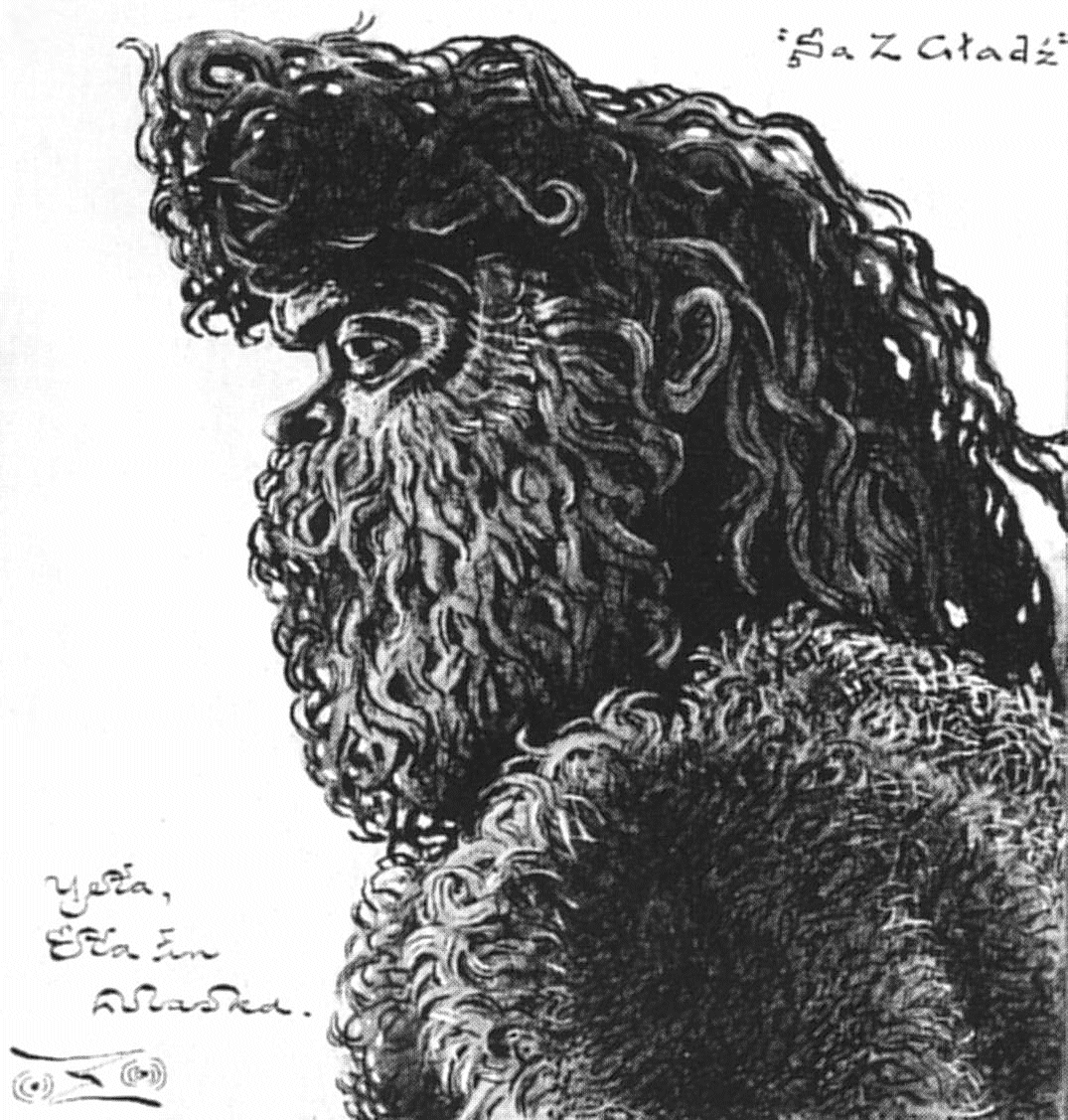September 2023 update: My new novel, DEAD MONKEY RUM, revolves around the work of visionary artist Stanislaw Szukalski. To find out more about this book, click HERE!
April 2019 update: The last chapter of my new book, BELA LUGOSI AND THE MONOGRAM NINE (written in collaboration with Gary D. Rhodes), is all about the artwork of Stanislaw Szukalski and its connections to 1940s horror cinema, particularly THE RETURN OF THE APE MAN starring Bela Lugosi. If you're interested in reading this chapter, you can purchase a copy of the book by clicking right HERE.
Though he was born in Poland in December of 1893, Szukalski lived and worked in Burbank, California for several decades until his death in May of 1987. His eccentric artwork, which include drawings as well as masterful sculptures, were eventually embraced by an eclectic mixture of notable Southern Californians such as Glenn Bray, Leonardo DiCaprio, Robert Williams and Jim Woodring (among many others). If you haven't seen a copy of Szukalski's book Behold!!! the Protong, available from Last Gasp, you truly don't know what you're missing. The subtitle of my first book (i.e, "Conspiracy Theory as Art Form") could easily apply to both the life and work of Stanislav Szukalski. Perhaps no one ever went quite so far to transform a theory into an art form as much as Szukalski.
Szukalaki's theory is a rather complicated and peculiar one, but Richard Chang of the Orange County Register offers a fairly accurate condensed version of it in the excerpt below:
"...Szukalski developed the pseudoscientific-historic theory of Zermatism – the belief that after the biblical flood of Noah's time, as described in the Book of Genesis, mankind fled to two main high-ground locations – Easter Island and Zermatt, Switzerland (hence, 'Zermatism').
"He used pictographs to illustrate how these locations provided the origins of a single, ancient language – Protong (his own term). He also believed that the human race had bred with a competitive race of Yeti (Abominable Snowmen or Bigfoot, for the uninitiated), and the result was a hybrid that polluted the purity of homo sapiens. Szukalski argued further that the hybrids were responsible for many of people's problems throughout history.
"While his evolutionary theories are fascinating, they're bizarre and highly unscientific, and through the decades, no other legitimate source has backed them up. Szukalski's drawings in the Fullerton exhibit do encompass some of his ideas, but they merely scratch the surface of what appears to be a labyrinthine Pandora's box of contorted conceptions.
"A significant amount of Szukalski's work is believed to have been destroyed in Poland, particularly during World War II. But some of it survived in a trunk left in California. A 1920s sketchbook in a glass case, with the title 'Lest We Forget' stenciled on the cover, contains intricate and amazing sketches. A video nearby helps disclose some of these works, which were created on plebian, daily journal paper.
"In Poland, Szukalski wrote and illustrated a mythological tale titled 'Rege Rege.' Several illustrations from a later, longer version are in the Begovich exhibit, and they demonstrate how detailed, wild and cinematic his vision was."
[END OF EXCERPT]
[If you want to read the entirety of Richard Chang's article about the Szukalski exhibit, click HERE.]
A few years before the Fullerton show, on October of 2009, I attended an exhibit that featured the work of Szukalski and--as an added bonus--the infamous Richard Shaver, an American painter and Hollow Earth theorist whose ideas about Earth's secret history weirdly parallel Szukalski's. I was so impressed by this show that I wrote a review of it the second I returned home. This review was published about a week later (on October 24th, 2009) on paranoidsonline.blogspot.com. The curator later told me that I was the only writer who'd actually bothered to cover the exhibit, which stunned me. But perhaps I shouldn't have been very surprised....
For your edification, here's the full text of my review:
The Mad Genius of Richard Shaver & Stanislav Szukalski
by Robert Guffey
On October 16, 2009, I had the privilege of attending one of the oddest gallery shows in recent Southern California history entitled “Mantong and Protong: Richard Sharpe Shaver and Stanislav Szukalski.” This exhibit was the brain child of curator Brian Tucker, director of the Pasadena City College Art Gallery. Despite being modest in size, limited to two rooms the size of an average studio apartment, the exhibit itself possessed a scope that was almost cosmic in nature. Though Shaver and Szukalski were no doubt unaware of each other’s existence, both have a great deal in common. Tucker was perceptive enough to notice these subtle links and build an entire show around them.
Both gentlemen, in the end, could be considered Outsider Artists. Much of their work was completed well outside the scrutiny of the modern art world. Indeed, it’s doubtful that either individual perceived the bulk of their work to be “art” in any traditional sense of that word. Their art objects were merely adjuncts to a utilitarian goal: to prove a scientific theory considered to be off-the-wall by mainstream society.
Both men achieved some level of fame early in their lives. In 1943, at the age of 36, Shaver became infamous among American science fiction fans for a series of outlandish articles and stories he wrote for Ray Palmer, editor of Amazing Stories Magazine. Shaver claimed he was in contact with monstrous beings who lived beneath the Earth. Some of these beings were called “Deros,” short for “Detrimental Robots.” These Deros had been beaming messages into Shaver’s head for quite some time. They had even taught him about the hidden history of the human race, including a long lost ur-language called “Mantong,” the source of all human language existing on Earth in the present. To the dismay of rationalist science fiction fans the world over, hordes of readers began writing letters to the magazine insisting that Shaver was correct—they, too, had received messages from the subterranean Deros! What became known as “The Shaver Mystery” continued to be a popular, though extremely controversial, topic in science fiction fandom for a period of about ten years. Eventually, however, Shaver drifted into obscurity and began turning his attention to even stranger pursuits.

One of these endeavors resulted in a series of almost surrealist paintings and photographs based on images Shaver claimed to have discovered imprinted on the interior of ancient rocks. Some of these pieces bear titles that would seem right at home in an exhibit of Robert Williams paintings, e.g.: “Action Photo of a Crazy Codfish Attacking A Lugubrious Flounder Taken At Forty Fathoms.” Shaver claimed that the destruction of a pre-Deluge civilization had somehow been recorded as images stored within these rocks. Shaver painted what he saw in a valiant attempt to help the rest of the human race witness the apocalyptic images that—he felt—should have been plainly obvious to anyone with eyes to see.
According to Tucker, in the 1960s Shaver even went so far as to mail a couple of his rocks to President Lyndon Johnson along with a note urging the President to assign a team of scientists to study these hidden images before the Russians beat America to the punch. President Johnson’s reaction to this letter is not known, but one hopes those Shaver rocks are still sitting unobtrusively on a mantle in the Oval Office.
Like Shaver, Stanislav Szukalski also achieved some measure of fame in his younger days. According to Tucker, Szukalski was “a celebrated artist from Poland […] best known for his detailed and elaborately symbolic sculptures that combined elements evocative of European avant-garde and Meso-American iconography.” Like Shaver, Szukalski spent the latter part of his life constructing a unified field theory of human pre-history. The ultimate outcome of this theory was the 1982 book Behold!!! the Protong in which he claimed to have discovered the root of all language, known as “the Protong.” Like Shaver, he believed the human race was at war with an evil group of beast-like creatures who represented the devolution of the human race; in this case, the creatures were the result of humans mating with Yetis millennia ago. Like Shaver, Szukalski’s works would have been completely lost if not for the untiring efforts of a small group of admirers who didn’t wish to see his unique oeuvre tossed into the dumpster.

Szukalski himself cut up his voluminous notes and drawings with a razor blade in order for them to be seen more clearly on video during an interview conducted by Glenn Bray, the man responsible for preserving much of Szukalski’s work. Shaver’s equivalent to Glenn Bray in his own life was the aforementioned editor, Ray Palmer. If not for Palmer, who published many of Shaver’s paintings in his 1975 book The Secret World, the entirety of Shaver’s work would have been completely unknown. Indeed, some of Shaver’s paintings were turned over and used by its creator as signs advertising his pottery business; one of them was even used a doggie door! Tucker cleverly includes photos of these paintings’ backsides next to the original in order to demonstrate how little regard the artist himself had for his own work.
Though both achieved a certain measure of fame—or at least notoriety—early on, Shaver and Szukalski ended their lives as true Outsider Artists. Like Henry Darger (an Outsider Artist if ever there was one), both Shaver’s and Szukalski’s major works were destined to have been lost forever if not for the intervention of mere luck and happenstance. It makes one wonder how many other mad geniuses have had the work of a lifetime discarded by unsympathetic relatives or landlords annoyed by their former tenant’s unbearable eccentricities.
Fortunately, one can witness in person—for a short time—a slight fragment of the inner lives of these two mad geniuses at the Pasadena City College Art Gallery, at least until November 14, 2009, the day the exhibit closes. One hopes that some canny publisher will see the exhibit and commission Brian Tucker to produce a book-length version of MANTONG & PROTONG so future generations can marvel at the eerie synchronicities linking the intense, chimerical visions of these two unique 20th century artists.
For more information about Stanislav Szukalski's artwork, click HERE.
For more information about Richard Shaver's artwork, click HERE.






